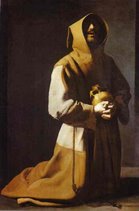In MacMillan’s Romeo and Juliet (music by Prokofiev), at the end of the famous balcony scene where Romeo and Juliet have declared their love, Rudolf Nureyev plants his left foot and stretches his back leg in a long line (fourth position), and from the small of his back, stretches his chest upwards towards Juliet (Margot Fonteyn), giving her his heart. This is the purest demonstration I’ve seen that turnout, one of the hallmarks of Western classical dance, is not just about turning out at the hips so that the feet form a 180 degree line. Turnout is instead a physical and moral commitment to open outwards and upwards from the major vertical axis of the body, straight through one’s head and heart, and reveal the soul. The soul of Nureyev’s Romeo is about two inches outside of his body, drawn towards Juliet as Fonteyn crosses her hands over her heart.
Violette Verdy’s Eurydice and Francisco Moncion’s Orpheus (Balanchine’s Orpheus, music by Stravinsky) move around an identical axis after he’s rescued her from Hades. They do tango steps, legs entwined, and she surrounds him to plead with him to look at her. She wraps her legs entirely around his body – around his waists and thighs, and in a back bend begs. He removes his blindfold, eyes lifted towards heaven, and she collapses dead on the stage.
Spurned by her lover Solor, Altynai Asylmuratova as Nikiya (in La Bayadere, original choreography by Petipa and music by Minkus) turns her back to him, goes on to her knees, extends her left leg behind her, arches her back and cries to the gods, hands clasped above her head.
In Balanchine’s Diamonds pas de deux (music by Tchaikovsky), Suzanne Farrell releases Peter Martins’ hand and balances for a moment on her left leg with her right leg held high (developpe a la seconde). She drops her leg in an arc like the swing of a pendulum, bourrees towards Martins (those tiny steps on pointe – Farrell’s here look like moving ripples in water), does a double inside-out pirouette which blinds her to where Martins actually is, establishing their trusting relationship; she kicks and pauses, her torso bent over an extended leg, creating an image of a unicorn, and instantly tosses her torso and extended leg backwards. Suddenly she is the image of a vulnerable woman, neck and breast exposed, arm behind her in submission, and her leg (in attitude) recreates the lines that form the conch shell, the golden mean. Farrell is the hunted, the hunter (“on the scent of her own mystery” as Croce wrote), and the archetypal woman.
Allegra Kent, in her idiosyncratic reading of the second movement of Balanchine’s Symphony in C (music by Bizet), releases her arms from a circle above her head into the space in front of her as she is spun around – she releases her energy, draws it into herself again, then gives it away once more.
Near the end of Suzanne Farrell’s solo in Der Rosenkavalier Waltz (music by R. Strauss from Balanchine’s Vienna Waltzes), on a dark, empty stage where her imaginary lover has once again disappeared, she rushes to go off stage, pauses, and as she does the famous backbend of supplication, she disappears in the brightness of all the stage lights coming on at once.

No comments:
Post a Comment